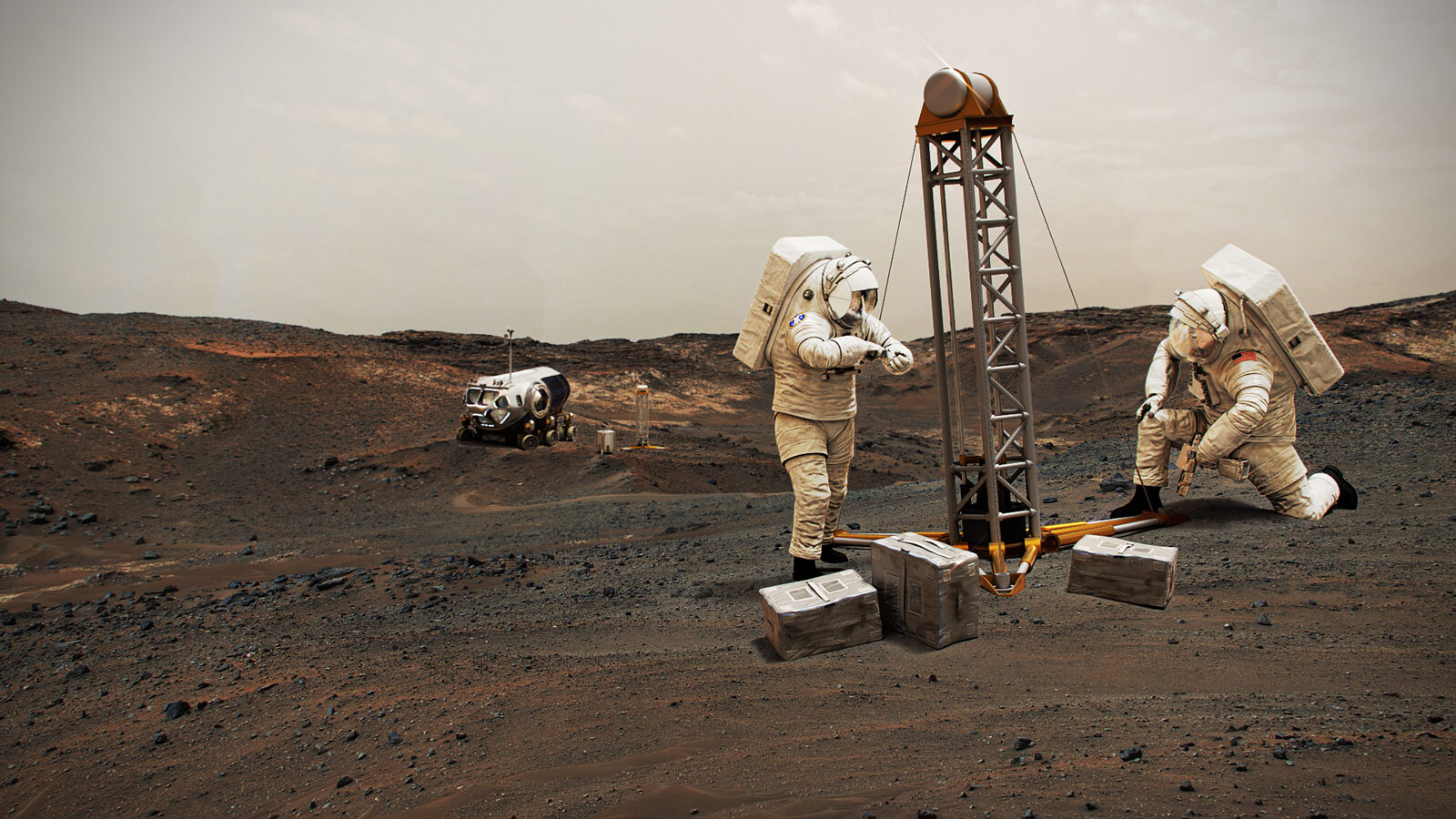


As global space agencies continue to make plans for colonizing Mars, scientists have identified a variety of materials that can serve as protection against hazardous cosmic radiation. This study, led by researchers from the University of Patras and NYU Abu Dhabi, evaluated different materials using computer modeling and actual data from NASA's Curiosity rover. The development has implications for the safety of astronauts on extended Mars missions, as the planet's arid and exposed environment poses a significant risk for prolonged human exposure to radiation.
Protecting Astronauts from Cosmic Radiation on Mars: Advancements in Radiation Shielding
As humankind ventures beyond Earth's protective atmosphere, ensuring the safety of astronauts on extended space missions becomes paramount. One of the major challenges faced by astronauts exploring Mars is the harsh cosmic radiation environment, which poses a significant risk to their health.
Cosmic rays are highly energetic particles that originate from outside the solar system and can penetrate the thin Martian atmosphere. Exposure to these rays can cause DNA damage, leading to an increased risk of cancer and other health issues. To mitigate this risk, scientists have been actively researching and developing protective materials to shield astronauts from radiation.
Advancements in Radiation Shielding
Recent research by a team from the University of Patras and NYU Abu Dhabi has identified a variety of materials that can effectively reduce radiation exposure. Using computer modeling and data from NASA's Curiosity rover, they evaluated the effectiveness of different materials, including:
Implications for Human Exploration
The development of effective radiation shielding materials is crucial for the safety of astronauts on extended Mars missions. The study's findings provide valuable information that will inform the design of spacecraft and habitats to minimize the risk of radiation exposure.
Top 5 FAQs and Answers
1. What is cosmic radiation? Cosmic rays are highly energetic particles from outside the solar system. They consist primarily of protons and atomic nuclei.
2. Why is cosmic radiation a hazard on Mars? Mars has a thin atmosphere and a weak magnetic field, leaving it vulnerable to cosmic radiation. Prolonged exposure can damage DNA and increase the risk of health problems.
3. What materials are effective for radiation shielding? Synthetic fibers with high hydrogen content and materials used in NASA's CREE experiment have been identified as effective radiation shields.
4. What are the current efforts to develop radiation shielding? Ongoing research continues to explore new materials and technologies for shielding astronauts from cosmic radiation.
5. How will radiation shielding impact future Mars missions? Effective radiation shielding is essential for the success of extended Mars missions by ensuring the safety and health of astronauts.

In a recent family vlog, Indian celebrity couple Shoaib Ibrahim and Dipika Kakar shared their "natural" hair care routine for their son, using a homemade mask made with rice flour, flax seeds, and coconut oil. However, experts warn that what works for adults may not be suitable for babies, whose sensitive skin and scalp could react to the ingredients. While the ingredients may improve hair texture, they do not necessarily promote hair growth. Instead, a healthy diet and good scalp care are more important in maintaining healthy hair.

A recent consumer study has found multiple brands of soft contact lenses in the U.S. to contain "forever chemicals" that can be harmful to both the body and the environment. The study, conducted by the nonprofit organization Environmental Health Sciences, tested 18 varieties of popular contact lenses and found all of them to contain markers for PFAS. Brands such as Acuvue, Alcon, and CooperVision were among the list of affected products. This news serves as a cautionary lesson on the potential risks of overusing contact lenses.

On the birth anniversary of Dr. APJ Abdul Kalam, the ‘Missile Man’ of India, tributes pour in on social media celebrating his life, vision and impact. A visionary scientist, inspiring leader and true patriot, Dr. Kalam's humility, compassion and constant interaction with students continue to inspire generations. His tireless efforts in defense, science and youth empowerment have strengthened India's path towards self-reliance and his legacy continues to motivate young minds to dream big and work hard for the nation.

Recent studies have found that extreme heat, particularly when combined with high humidity, can have a significant impact on mental health. A study in India showed that when wet bulb temperature exceeded 27°C, the probability of reporting severe depression increased by 0.5%, even when the temperature was slightly lower. This finding is consistent with global reviews that have linked high temperatures to mood disorders, increased hospital admissions for psychiatric conditions, and even elevated suicide risk. The Lancet has also published evidence that rising temperatures worldwide are a growing threat to emotional and cognitive health.

In a meeting with university officials in Udaipur, Rajasthan Governor Hari Bhau Bagde stressed the importance of incorporating India's ancient knowledge traditions into academic research. He highlighted the deep repository of knowledge in India since ancient times and urged scholars and scientists to draw upon this tradition in their work. Bagde also suggested making ancient texts available in university libraries for study and research purposes, in order to shape the intellectual abilities and love for the nation among the younger generation.

John Clarke, Michel H. Devoret, and John M. Martinis have been awarded the 2025 Nobel Prize in Physics for their pioneering research into quantum mechanical tunnelling. Their discovery has opened new possibilities for quantum technologies, and will be formally presented on December 10, the anniversary of Alfred Nobel's death. This announcement follows the tradition of recognizing transformative contributions to science, and the award carries a prestigious prize of 11 million Swedish kronor.

The US-Japanese trio of Mary E Brunkow, Fred Ramsdell, and Shimon Sakaguchi have won the 2025 Nobel Prize in physiology or medicine “for their discoveries concerning peripheral immune tolerance". Through their research, they have shown how the immune system is kept in check and why serious autoimmune diseases do not affect everyone. Sakaguchi found a new class of T cells, while Brunkow and Ramsdell discovered the explanation behind a specific mouse strain's vulnerability to autoimmune diseases. Together, they have significantly advanced our understanding of immunology and autoimmune diseases.

Indian astronaut Shubhanshu Shukla, who recently completed a 20-day space mission, shared his insights and experiences at the convocation ceremony of Dr. APJ Abdul Kalam Technical University. He highlighted the importance of patience, focus, and the inevitability of change in achieving success, and urged the graduating class to actively contribute to shaping a fearless and ambitious India.

The Regional Meteorological Centre (RMC) in Chennai has issued a weather alert for parts of Tamil Nadu, with thunderstorms and light to moderate rainfall expected on Saturday. The alert was issued due to the strengthening of a cyclonic circulation in the Bay of Bengal, which is likely to intensify and form a low-pressure area. The system is expected to affect Tamil Nadu, Puducherry, and Karaikal, with some areas experiencing heavy rainfall and gusty winds. The public is advised to stay updated and take precautions, especially in hilly and western districts.

As a step towards advancing India's deep-sea research capabilities, the Union Science Minister announced a landmark contract with the International Seabed Authority to conduct mineral exploration in the Indian Ocean for the next 15 years. This move will not only help India in expanding its scientific knowledge about the deep sea but also has the potential to strengthen its position as a leading player in the international seabed mining industry.